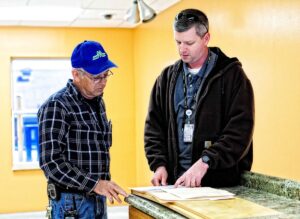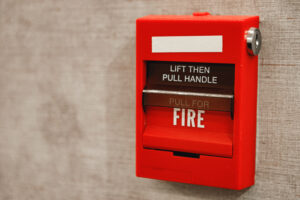According to laddersafetymonth.com, over 100 people every year die in ladder-related accidents, and even more suffer disabling injuries. National Ladder Safety Month was created to promote ladder safety, both at home and at work, by raising awareness of the importance of safe practices when using ladders.
To do our part to support ladder safety, we spoke with John Roberts, the Site Safety and Health Officer at NSA Panama City, FL, about job site safety. John explained that while the group he works with is small, they still take extensive measures to make sure everyone keeps safe. One of the biggest safety concerns that their group faces is ladder safety.
The ladder safety risks are addressed by ensuring that everyone is trained on ladder safety and usage. When it comes to using ladders, there are a lot of things to consider.
- What type of ladder should be used for this job? A Folding Ladder? An Extension Ladder?
- What material should the ladder be made of? If they are working with electricity then fiberglass, if not, then aluminum.
- What height of ladder should I choose? It is important for the ladder to be the right height, not too tall or short.
- Is this ladder damaged? Are the cleats working properly? Are the rails in good shape? Are there any cracks or broken rungs? Any type of damage to a ladder should be assessed and, if necessary, the ladder should be replaced.
- Is there a clear label on the ladder? Ladders have labels that indicate important information like weight rating. When choosing a ladder you want to make sure that it can support your weight, plus any materials or tools that may be carried. If the ladder is missing a label or the label is damaged or unclear, most manufacturers will send replacements to encourage safe usage.
Once the team is trained on how to choose the correct ladder, they are trained on proper usage. This includes making sure that an extension ladder is positioned so that the top of the ladder is at least three feet over the edge that they will be stepping on to at the top. Also, if there is electricity nearby, the base of the ladder must be at least 10 feet from the electrical source depending on the voltage.
John advocates that the biggest thing to keep in mind when training people in ladder safety is to make it easy to remember. The more difficult the instructions, the less likely that people are to remember them. He offers easy ways to remember instructions so that he can make sure that his team makes it home each day.
The last thing that John wants readers to know, is that they should never hesitate to ask questions. He says, “I have a good working relationship with my team. I am not the safety police. I want to keep everyone from getting hurt.” He explained that when people have questions and learn the reason why safety protocols are in place, they are more willing to follow them.
We hope that this has been helpful and The Ginn Group encourages everyone to practice ladder safety! For more information about the work that we do at NSA Panama City, FL, visit our Success Stories page.








